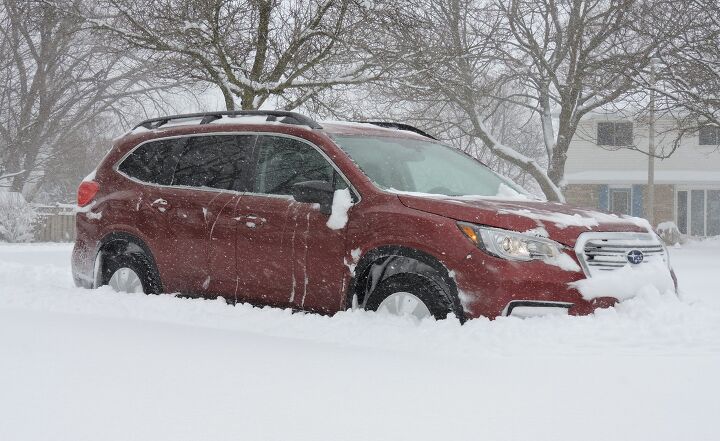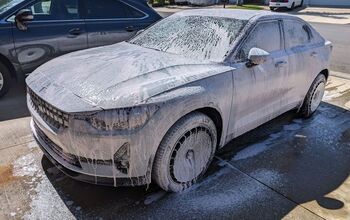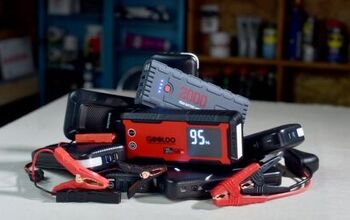Sailun IceBlazer WST2 LT Winter Tire: Long-Term Review

*Final Update Posted May 4th, 2022*
Editor’s Note: With winter in full swing, AutoGuide arranged for Mike Schlee to test out the Sailun WST2 LT winter tire over the next several months. Mike was not directly compensated for his review.
There was a time when Sailun Tires were an unknown quantity in North America. It was just another value-oriented tire brand fighting for market share in a sea of manufacturers. But over the past decade, that’s all changed.
Sailun has developed a devoted following of consumers who appreciate the value and performance provided by the brand. In the interest of full disclosure, I have been one of the converts. Since I reviewed my first set of Sailuns, I have been impressed with the tires ability to stack up to far more expensive competition.
Aside from reviewing Sailun products, I’ve put my money where my mouth is and purchased a few sets over the years for my personal vehicles. But that was then, and this is now. The tire industry evolves at a rapid pace, and I haven’t sampled a set of Sailun winter tires in quite some time. Does the brand still provide a very good tire for an excellent price? Or has the competition passed the manufacturer by?
Table of contents
Sailun IceBlazer WST2 LT Details
To find out, I am spending the winter with a set of Sailun IceBlazer WST2 LT studdable tires. This is the tire manufacturer’s light truck winter tire designed for crossovers, SUVs, and pickup trucks. It is available in various sizes for wheels, from 16 inches in diameter to 20 inches. I have installed a set of them in 245/60R18 on a 2020 Subaru Ascent, and will not be installing studs. I will be updating this review all winter long as I spend more and more time with the tires.
The WST2 LT is a more aggressive winter tire, as much an all-terrain tire as it is a cold weather specialist. It features a big blocky tread design, with a zigzag sipe arrangement intended to tackle snow, slush, and mud. Sailun has also focuses on ride comfort.
To start, the tires have 13/32 of an inch (10.1mm) of tread, and I will be monitoring this over the course of the winter.
Initial Impressions
The tires do look aggressive, especially on an unsuspecting crossover like an Ascent. Being an all-terrain-based winter tire, they are nosier than the Ascent’s standard all-season tires, or my previously installed road-based winter tires. There is a gentle hum on secondary roads and highways, as well as a very faint vibration that can be felt through the gas pedal at certain speeds. It’s not problematic or distracting, just noticeable.
Ride comfort is quite good, as the tire’s sidewall is not so stiff that it crashes over road imperfections, yet it’s not too soft to hamper handling. I couldn't discern a difference in how the Sailuns perform compared to the previous higher-priced name brand tires they replaced.
First Update - A Small Snow Test
My first real snow test was slushy, thick, wet snowy mess. The kind that falls in large flakes and accumulates on the ground as either snow, ice, or slush. Road surfaces become unpredictable as there’s no telling what exactly is lying under that top white layer.
But the WST2 LT’s didn’t care. Grip in these conditions is nothing short of fantastic—it is where the tires really shine. It’s the benefit of the trade off for a bit of road noise; the traction these tires provide when things get sloppy. They match the grip of the pricier tires I previously had on this vehicle.
Acceleration from a stop is no problem, even if it’s not a straight line. The WST2 LTs don’t give up traction when tasked with turning and accelerating like some winter tires do. There is no drama while braking, either. The tires grip as expected, with no unwanted motions or squirm.
Probably the best attribute to the tires is that they are predictable. I didn't experience any sudden loss of traction, and they're very progressive in losing grip when pushed too hard for the conditions. It’s confidence inspiring, as the driver always knows when the tires are working, and when it is time to slow down.
This was just a lighter snow though, a few inches at most. To date, I have driven a total of 295 miles (475 km) on the tires. As mentioned, I will be updating my experiences with the Sailun WST2 LTs over the course of the winter, including their performance on ice and deep snow, as well as observed tread wear. Check back periodically for new content.
Second Update – Extreme Snow
Winter was looking like a bust. Other than the minor bit of snow mentioned in part one of this review, we had been getting off easy. No real snow falls had occurred, and other than a few very frigid days, winter’s fury was absent.
But then it hit. A winter storm like we haven’t had in years, if not decades. A blast that dumped upwards of 20-inches of fluffy white powder in just few hours one Monday morning.
While most wrote the day off, I’m not one to pass up an opportunity, and here was the ultimate test for the Sailun IceBlazer WST2 LT tires. I headed out to clear the mountain of snow that had formed on my trusty test vehicle, a 2020 Subaru Ascent.
Yes, the Ascent is a very capable winter vehicle. It’s a Subaru after all; a company that stakes the brand’s reputation on all-wheel drive capability. So, it may seem disingenuous to test a winter tire on a supreme winter vehicle.
But tires are crucially important to ensure the vehicle’s full potential is utilized. It’s like a car’s footwear. Usain Bolt wouldn’t have won gold medals wearing a pair of wooden clogs. Sidney Crosby wouldn’t have won three Stanley cups running around the ice wearing slip on loafers. And as I would soon find out, an improperly equipped vehicle stood no chance on this day, regardless of what it is.
Second Update – Snow Test, To The Max
I had a route all planned out in my head. I’d drive around, conduct my test, and snap a few pretty pictures. The snow on our unplowed roads was higher than the front bumper of the Ascent, which meant I was a pseudo snowplow as I drove around. I made it two blocks before the severity of the storm really sunk in.
Three city buses blocked the road ahead, stuck on the gentlest of inclines, rear axles buried in the snow, long metal bodies pointed in various directions, like an awkward mechanical ballet. I would find out later that over 1,000 buses in the greater Toronto Area would be stuck and abandoned that morning.
But it wasn’t just the buses. Front-wheel drive cars, even with winter tires, were getting no traction on the roadways. Two Subaru Imprezas were left abandoned in the middle of the road where snowdrifts exceeded three feet. What started out as a winter tire test, quickly became a neighborhood assist program. Everywhere I went I was sure to find another vehicle stuck in the snow that required some neighborly help to get back on the road.
And I could go anywhere. No matter how deep the snow was, the car just kept pushing forward. At times, snow was so deep it would hit the Ascent’s grille and push up over the hood. But the Sailun’s never lost gip and the vehicle just keep moving forward with minimal effort.
While trying to navigate around block roads, I needed to detour down side streets that were yet to see any vehicular activity since the snow had started. More than once, that meant punching a hole through a snowplow-made-snowbank that reached over the Ascent’s hood – more than 40 inches high. But even that was no issue, I just pushed through, got traction, and continued with my travels.
Granted, most of us will not experience snow like this regularly. In fact, there’s a chance a storm like this won’t happen during the entire ownership period of a vehicle. But if the Sailun IceBlazer WST2 LT tires work this well in appalling conditions, they should be fine in much lighter snow. My hope is to still test them in moderate snow, freezing rain, extreme cold, and deep slush. We’ll see what Mother Nature has in store for the rest of the season but be sure to check back here next month for another update.
Third Update - When the Cold Gets Colder
It’s been two and a half months since we installed our set of Sailun IceBlazer WST2 LT winter tires and it seems like every bit of wintery weather has been thrown at us. Over the course of 1,138 driving miles, we’ve encountered record breaking snowfalls, ice storms, and extreme cold.
We’ve covered in depth how the tires handled various levels of snowfall, now it is time to move onto the two other aspects: extreme cold and ice.
Although it gets colder in many regions of North America, we did experience a few cold snaps this winter that saw temperatures dip down to the -25C to -30C range. For our American readers, that’s -13F to -22F.
When temperatures get this low, a lot of tires become quite susceptible to freezing. In any conditions, the weight of a vehicle makes tires wider and flatter at the bottom, and when parked, it remains in this position for quite some time. In extreme cold, the tire can become frozen into that shape.
Driving a car after it has been parked for a while in frigid temperatures produces what some describe as a square tire feel. There’s a noticeable divot in the tire as it rotates since it isn’t fully round yet. This goes away after the tire warms up, and how long that takes depends on the tire.
But with the Sailun IceBlazer WST2 LT tires, there was no square-feeling, even in these temperatures. Moments after leaving our driveway the tires felt the same as they did when temperatures were at the freezing mark.
Third Update - Ice, Ice Baby
Winter really has been unkind this year. In the past month we have been unlucky enough to twice get the type of storm that begins as a deluge of rain before transitioning into ice, followed by snow.
These conditions create a scenario where there is a top layer of snow, hiding anything from gooey slush to slick ice underneath. Of course, I went out and tested after these storms. I found that if the top layer of snow was present, driving around was completely drama free. The Sailun’s continued to grip as acceleration, turning, and braking were predictable with no unexpected traction loss.
Where the road had the top layer of snow removed by a snowplow, conditions were worse and more treacherous. All the exposed slush began to freeze into hardpacked sheets of ice. Driving on these various-surface roads was a little more unpredictable.
The tires would slip under acceleration, although forward momentum and progressions was never lost. If I got a bit too ambitious with cornering speed, as long as I back off the throttle, the tires regained traction predictably. Braking too needed a delicate touch, but the tires would bite into any traction that was present. Overall, I would give the tires a good rating on ice, slightly lower than their excellent rating in snow.
I’ve now experienced just about every winter condition possible. But the review isn’t over yet. I will do one final update when the tires are switched off for the season, focusing on their warmer, early spring performance as well as seeing how tire wear is faring. Check back in a few months.
Final Update - The Thaw into Spring
In the end, I couldn’t have chosen a better winter to evaluate the Sailun IceBlazer WST2 LT winter tires. Not only did we have a bit of everything this season, but Jack Frost refused to release his grip on our region. But thankfully that is finally all behind us and Spring has sprung. So earlier this week we removed the Sailun IceBlazers off our sturdy chariot to conclude our time with them.
Although we had an elongated winter, March and April were not all doom and gloom. There were a few days where temperatures eclipsed 65 degress F. This may not sound overly warm, but for dedicated winter tires, this is exceedingly hot. This is the point where a lot of soft rubber intended for snow and ice becomes overtly squirmy, making a vehicle feel like it is riding on a thin layer of goo.
I’m happy to report that the Sailun’s did not exhibited this unwanted trait, even as the barometer spiked upward. Whether it was well below freezing or t-shirt weather, the WST2 tires behaved the same way.
When we did remove the tires, our vehicle’s odometer showed we had driven 2,081 miles on the tires. A quick measure of the tread depth showed the rear tires were still at the same 13/32nds as when we installed them while the front tires were only down to 12.5/32nds. That’s more than acceptable tire wear and with regular rotations, these tires should last a long time.
After 4 months of testing through a wide variety of conditions, I can conclude that the Sailun IceBlazer WST2 LT is a very good tire at a great price.
Pros | Price, extreme snow performance, ride comfort |
Cons | Road noise, minor vibrations |
Bottom Line | A very good tire for a great price |

A 20+ year industry veteran, Mike rejoins the AutoGuide team as the Managing Editor. He started his career at a young age working at dealerships, car rentals, and used car advertisers. He then found his true passion, automotive writing. After contributing to multiple websites for several years, he spent the next six years working at the head office of an automotive OEM, before returning back to the field he loves. He is a member of the Automobile Journalists Association of Canada (AJAC), and Midwest Automotive Media Association (MAMA). He's the recipient of a feature writing of the year award and multiple video of the year awards.
More by Mike Schlee












































Comments
Join the conversation
Have SAILUM TIRES on my GM truck. Never had I such confidence with then . Heavy loads/ or Empty Great Safe rides!
Vos voitures sont vraiment magnifiques